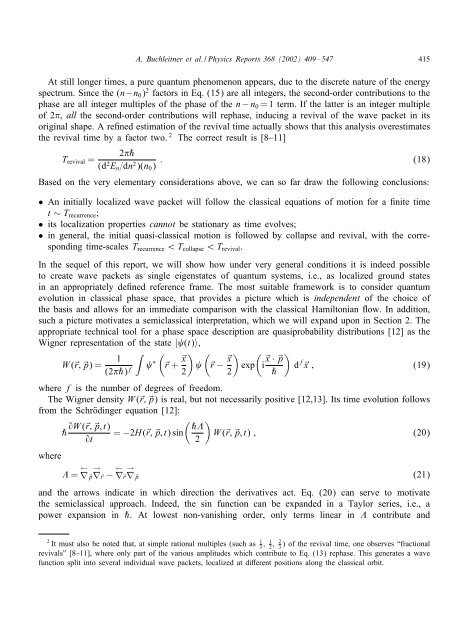Non-dispersive wave packets in periodically driven quantum systems
Non-dispersive wave packets in periodically driven quantum systems
Non-dispersive wave packets in periodically driven quantum systems
Create successful ePaper yourself
Turn your PDF publications into a flip-book with our unique Google optimized e-Paper software.
A. Buchleitner et al. / Physics Reports 368 (2002) 409–547 415<br />
At still longer times, a pure <strong>quantum</strong> phenomenon appears, due to the discrete nature of the energy<br />
spectrum. S<strong>in</strong>ce the (n−n0) 2 factors <strong>in</strong> Eq. (15) are all <strong>in</strong>tegers, the second-order contributions to the<br />
phase are all <strong>in</strong>teger multiples of the phase of the n − n0 = 1 term. If the latter is an <strong>in</strong>teger multiple<br />
of 2 , all the second-order contributions will rephase, <strong>in</strong>duc<strong>in</strong>g a revival of the <strong>wave</strong> packet <strong>in</strong> its<br />
orig<strong>in</strong>al shape. A re ned estimation of the revival time actually shows that this analysis overestimates<br />
the revival time by a factor two. 2 The correct result is [8–11]<br />
2 ˝<br />
Trevival =<br />
(d2En=dn 2 : (18)<br />
)(n0)<br />
Based on the very elementary considerations above, we can so far draw the follow<strong>in</strong>g conclusions:<br />
• An <strong>in</strong>itially localized <strong>wave</strong> packet will follow the classical equations of motion for a nite time<br />
t ∼ Trecurrence;<br />
• its localization properties cannot be stationary as time evolves;<br />
• <strong>in</strong> general, the <strong>in</strong>itial quasi-classical motion is followed by collapse and revival, with the correspond<strong>in</strong>g<br />
time-scales Trecurrence ¡Tcollapse ¡Trevival.<br />
In the sequel of this report, we will show how under very general conditions it is <strong>in</strong>deed possible<br />
to create <strong>wave</strong> <strong>packets</strong> as s<strong>in</strong>gle eigenstates of <strong>quantum</strong> <strong>systems</strong>, i.e., as localized ground states<br />
<strong>in</strong> an appropriately de ned reference frame. The most suitable framework is to consider <strong>quantum</strong><br />
evolution <strong>in</strong> classical phase space, that provides a picture which is <strong>in</strong>dependent of the choice of<br />
the basis and allows for an immediate comparison with the classical Hamiltonian ow. In addition,<br />
such a picture motivates a semiclassical <strong>in</strong>terpretation, which we will expand upon <strong>in</strong> Section 2. The<br />
appropriate technical tool for a phase space description are quasiprobability distributions [12] as the<br />
Wigner representation of the state | (t)〉,<br />
W (˜r; ˜p)=<br />
1<br />
(2 ˝) f<br />
<br />
∗<br />
<br />
˜r + ˜x<br />
<br />
˜r −<br />
2<br />
˜x<br />
<br />
˜x · ˜p<br />
exp i d<br />
2 ˝<br />
f ˜x; (19)<br />
where f is the number of degrees of freedom.<br />
The Wigner density W (˜r; ˜p) is real, but not necessarily positive [12,13]. Its time evolution follows<br />
from the Schrod<strong>in</strong>ger equation [12]:<br />
<br />
9W (˜r; ˜p; t)<br />
˝<br />
˝ = −2H(˜r; ˜p; t) s<strong>in</strong> W (˜r; ˜p; t) ; (20)<br />
9t<br />
2<br />
where<br />
→<br />
∇˜p ∇˜r − ← →<br />
∇˜r ∇˜p<br />
= ←<br />
and the arrows <strong>in</strong>dicate <strong>in</strong> which direction the derivatives act. Eq. (20) can serve to motivate<br />
the semiclassical approach. Indeed, the s<strong>in</strong> function can be expanded <strong>in</strong> a Taylor series, i.e., a<br />
power expansion <strong>in</strong> ˝. At lowest non-vanish<strong>in</strong>g order, only terms l<strong>in</strong>ear <strong>in</strong> contribute and<br />
2 It must also be noted that, at simple rational multiples (such as 1<br />
3<br />
, 1<br />
2<br />
(21)<br />
2<br />
, ) of the revival time, one observes “fractional<br />
3<br />
revivals” [8–11], where only part of the various amplitudes which contribute to Eq. (13) rephase. This generates a <strong>wave</strong><br />
function split <strong>in</strong>to several <strong>in</strong>dividual <strong>wave</strong> <strong>packets</strong>, localized at di erent positions along the classical orbit.











